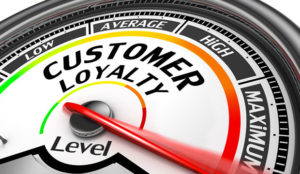A better customer journey is the roadmap businesses need to meaningfully improve their customer experience.
Bloomfire in May published a report that shows 88 percent of companies are ill-equipped to handle customer expectations, which have continued to rise during the pandemic. Companies also face the operational obstacles of integrating customer knowledge into workflows, cross-functional collaboration, and real-time access to consumer insights.
The results show that typically companies say their customer experience is a top priority for the next year. But only 12 percent say they currently have best-in-class CX strategies and processes in place.
Only 26 percent of all respondents said they have a single source of truth across their knowledge assets that is available company-wide and across the customer journey. Similarly, 45 percent of businesses reported that fewer than half of their CX decisions are made using data.
“The most agile and competitive businesses know that knowledge is a strategic advantage and have a best-in-class single source of knowledge,” said Mark Hammer, CEO of Bloomfire.
Hammer added, “The pandemic has accelerated both increased customer expectations and the move to a hybrid workforce, so this is a critical moment for companies to have the right knowledge engagement technology in place in service of helping gain insight into and deliver optimal customer experiences.”
The need for better customer journeys is a challenging goal. Overcoming operational challenges — becoming more agile in meeting customer needs and raising the maturity of the customer experience team — will be critical to staying competitive in an ever-changing business environment, he observed.
Study participants cited other obstacles to combining data and knowledge management as part of a mature CX strategy. The top four the survey revealed are the effort needed to keep information up to date, a lack of collaboration around important information, knowledge lost to employee turnover, and knowledge that exists outside of key workflows.
Uphill Battle
The most glaring sort of deficiency among today’s companies is just how unable they are to meet customer expectations. Finding out that only 24 percent of businesses reported having best in class was a big surprise to Hammer.
“You would think that in a modern workforce, and especially at a time that we are in now, that they would be equipped and using the data to drive decisions. But they simply are not, and this is self-reported, which makes it even stronger,” Hammer told CRM Buyer.
Another eye-opening result of the study was the consistency of responses in which everybody thinks that somebody else is handling the customer’s problem. Companies should view this as a customer opportunity, he added.
Hammer sees slow movement toward companies recognizing their need to improve the customer journey. The initial problem is that knowledge and people are siloed. To bring them together takes technology to do it.
Single Source of Truth
The goal is to build a single source of truth into a unified knowledge platform instead of keeping it stored in someone’s head, on another person’s laptop, and then some stuff on a SharePoint repository.
“It’s spread all over the place, and there is no easy way to access it. A knowledge engagement platform will bring all that together. It will be one place where people can search for the information and use it to drive decision-making and result,” Hammer insisted.
The single source of truth that Hammer preaches is the ability to take all of the accumulating stored knowledge, like videos and data on spreadsheets, and put them in one place that is searchable. That is simple, according to Hammer.
“It is really a Google for your business, and you have got a way to Google (search) for the documentation that exists in the organization, and everybody has access to it,” he explained.
The more people that have access to all that information, the smarter everybody is going to be together. That is what powers better decision-making, and more alignment between teams that alignment between teams is obviously critical.
“The only way to do that is if everybody is reading from the same net,” said Hammer.
Data Is THE Thing
Brands can use available data to understand customers’ behaviors, needs, and challenges across the customer journey lifecycle. Reviewing data like campaign performance, web page activity, and sales conversions help to understand what is resonating with customers, agreed Lynne DeRoch, vice president of strategic solutions at Whereoware.
“For example, looking at your site’s top referring search phrases gives you an idea of what customers are most interested in looking for. Also, reviewing the website product categories driving the most traffic or products being added-to-cart most frequently tells you what products are of interest or needed by customers once they get to your site,” she told CRM Buyer.
Brands can use that data to build promotional campaigns around those product categories. Similarly, if customers are adding these products to the cart but abandoning them, this tells brands customers are experiencing a challenge in the cart. In both these examples, the marketer must think through the users’ intent when taking action, explained DeRoch.
Go Even Further
Taking this a step further, using a tool like Mouseflow that records user activity on the website, brands can see exactly where the customer paused and then dropped off. This shows a source of friction.
The company can then develop a plan to reduce friction by reducing checkout steps, writing helper copy, and providing free shipping or an incentive. Or the company can create a follow-up email or retargeting ad to bring customers back to the cart, added DeRoch.
“By understanding where employees pause, get confused, or feel frustrated, the brand can make small but meaningful changes to improve conversions drastically,” she said.
Keys to Gathering CX Data
Retailers and marketers face two surmountable challenges to understanding different personas’ questions, concerns, interests, and needs across the customer journey, according to DeRoch. The first is ensuring they capture and analyze data. The second is parsing through available data to find meaningful, actionable information.
Every brand should have an analytics tool, like Google Analytics, to measure digital activity. Free reports in Google Analytics, like the Behavior Flow report, show brands the order of pages visitors land on, which can reveal areas of confusion or missed opportunities.
Similarly, webpages with low traffic may be too difficult to find or need better marketing. Today’s marketers should use all available data sources to understand their customers’ current journeys and then incrementally make changes to improve them.
Reviewing Google Analytics, brands can answer many questions like:
- What demographics make up my audience?
- Which campaigns are driving conversions?
- Are they using mobile devices?
- Are they new visitors or prospects?
- What channels are driving the most traffic?
- Where should I focus my marketing spend?
Next, brands should solicit information and preferences from customers directly. Listening on social media, surveying customers, and launching a preference center or user groups are great ways to get additional data directly from the source.
An example of actionable data, DeRoch offered is a user completing a web form to get a white paper. That conversion point (webform submission) gives the brand information about customers’ interests (the theme of the white paper) and allows them to send a follow-up email or engagement, either providing a complimentary content piece or thanking them for the download.
“The brand is able to take action, contextually based on the customer’s action, and can even automate the outreach,” she noted.
Depending on your business, actionable data may include website pages viewed, submitted preference center data, survey responses, downloads, or demo requests. It can also be purchases, newsletter sign-ups, search activity, and more.
Ongoing Process
“Optimizing your customers’ journey is a continuous process of analyzing your personas and the stages of the customer journey and seeking incremental changes to enhance and improve their experience. By revisiting the customer journey and performance, you will consistently improve customer outreach and satisfaction,” advised DeRoch about leveraging the customer journey.
To grow sales, marketers should focus on both the research and conversion stages. To maximize and retain customers, they should focus on a positive conversion/checkout and the post-purchase stage to make it easy for customers to buy and then offer incentives and reminders to return to your website for follow-up business.
“Post-sale is one area of customer journey management that is frequently overlooked,” she said.
Retaining customers is less expensive than acquiring new ones. Thus, the post-sale customer journey is a critical area to focus attention.
More CX Tips
The notion of CX is no different now for commerce in general (as in physical stores) and e-commerce. All customers want ways to easily shop, avoid crowds, and still get their items now, assured Shelly Socol, co-founder and CEO of One Rockwell.
“We see curbside pickup, in-store pickup, and same-day or two-day local delivery becoming more of a standard over the next year. It is easy to see that big retailers have already adopted these as their standards,” she told CRM Buyer.
In order for these options to function properly and not result in unexpected delays to the customer, merchants need to be on top of their inventory counts for all locations, and it needs to be fluid. This means that they must be able to easily reallocate their inventory quantities with limited system interruptions, overrides, and delays, she added.
Merchants today have so many ways to maximize the customer experience, especially online. Brands must find features to add to their site that works best for the brand and its customers.
“Just because one feature works well for one brand does not mean it is going to have the same success for all brands,” said Socol.
It is important to explore features that will drive traffic and revenue based on the brand’s customer behavior and not an overall trend, she observed. To complement the in-store experience, brands should consider exploring “try before you buy,” fit finder apps, and personalized recommended products.





























































Social CRM
See all Social CRM